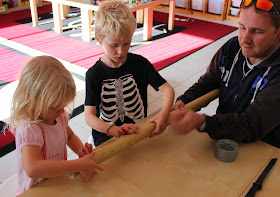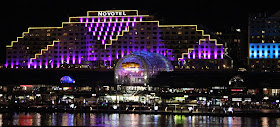Last night we went along the the annual Vivid Sydney festival. Here are some of our favourite light shows and video projections.
Pages
▼
Thursday, 29 May 2014
Vivid 2014
Last night we went along the the annual Vivid Sydney festival. Here are some of our favourite light shows and video projections.
Shining Armour
Today the children worked on some ceremonial armour for their treasure chest. L made a gauntlet whilst R made a shield. They used cardboard, metallic tissue paper, metallic acrylics and fake gems.
Sunday, 25 May 2014
Baking
This afternoon the children chose some recipes from their cook books. As usual their choices include cakes and biscuits. L made jammy biscuits and R made banana muffins.
The Georges River
Today we took a short bush walk at the Georges River. We trekked through the forest to the Basin swimming hole and stopped for a picnic at Simmo's Beach. The water is very cold at this time of year but will be lovely when summer returns.
 |
| The Basin |
 |
| Simmo's Beach |
Antony & Cleopatra
For the next couple of weeks we are studying Antony and Cleopatra by Shakespeare. We have started with this modern, easy read version. We'll be reading some of Shakespeare's original words soon and comparing the language to modern English.
The children summed up the story on these worksheets from "Better Than Book Reports" from Scholastic.
 |
| By R |
 |
| By L |
Wednesday, 21 May 2014
Jewels
The children have been using acrylic paints and fake gems to decorate some clay beads they made for their ancient treasure box. L also made a crown from metallic cardboard.
 |
| Golden goblet and coins by L |
 |
| Pendants by L |
 |
| Necklace by R |
 |
| Amulet by R |
Sunday, 18 May 2014
Storm Surge
Today we attempted to model the effects of storm surge in hurricanes. The children made a model coastal landscape with play-doh and Monopoly houses. We then added blue coloured water for the sea. Next we needed wind. We tried the hair dryer but just blowing the water seemed more effective. The low lying houses were flooded out.
Air crushing Can Experiment
Today we did an experiment to see that the air around us has pressure that is even strong enough to crush a can.
You need to heat a small amount of water in a can until it boils. The water vapour produced pushes air from the can. Quickly invert the can into cold water. The water vapour inside the can will condense causing the pressure inside to lower. The higher air pressure from outside the can is enough to crush it.
You need to heat a small amount of water in a can until it boils. The water vapour produced pushes air from the can. Quickly invert the can into cold water. The water vapour inside the can will condense causing the pressure inside to lower. The higher air pressure from outside the can is enough to crush it.
Wednesday, 14 May 2014
Mummy and Me
Today R and dad were at a computer programming workshop. L and I decided to have some quality time making a piece of collaborative art. This mixed media piece uses collage, acrylics, watercolours, and graphite.
Tuesday, 13 May 2014
Colourful, Musical Weather
Today we used our creative skills in our weather unit study. The children used our various percussion instruments to compose a piece of music to represent different weather such as rain, wind, thunder, snow and sunshine. We also made our own rain stick from a packing tube with nails pushed into it and filled with bird seed and rice.
 |
| Push some nails into a packing tube from all directions |
 |
| Seal the end then pour in some rice and bird seed |
 |
| Seal the other end and then tip up the tube to hear the rain sound |
We also investigated rainbows before trying this colour mixing experiment. Add some drops of food colour to a dish of full fat milk or cream. Drop in a little washing up liquid to break up the fat in the milk. Watch the colours mix.
We also got our glacier out of the freezer. Its made from water mixed with soil, sand and small stones. We sprayed a tin with oil and then coated it in flour to represent the soil and rock beneath the glacier. We slid our glacier over the surface and watched how it scoured the surface and added more material to its base.
The children also made these spirals to demonstrate the upward movement of warm air currents.













































